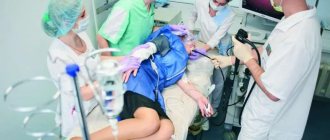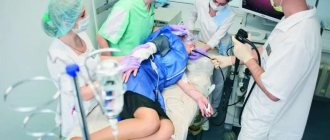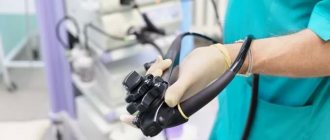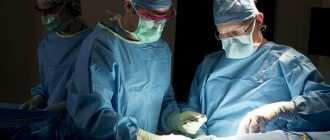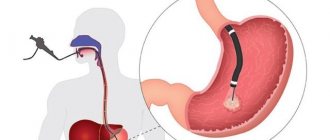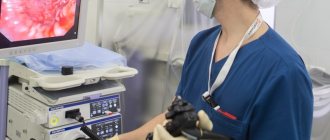The combination of fibrogastroduodenoscopy (FGS, FGDS) with fine-needle biopsy is a procedure performed using endoscopic equipment. This is a device that allows you to see the condition of these organs using a miniature video camera inserted into the esophagus and stomach. The doctor can see the condition of the mucous membranes and tissues on the monitor screen, and in a many times enlarged form.
This allows the doctor to visually highlight those areas of the stomach, esophagus or duodenum that are affected by any disease. The inserted thin probe is also adapted to allow the collection of biological material - a small amount of tissue that is suitable for morphological analysis.
There may be erosions, polyps, ulcers, and areas of inflammation on the gastric mucosa. There may also be areas of degenerating cancer cells. All these zones are visible during the examination, and the doctor has the opportunity to take tissue from these zones. In addition, with FGDS, sources of intragastric bleeding are visible, and this bleeding can even be stopped during the examination procedure itself.
What is a biopsy of the stomach and esophagus?
Despite the perfection of modern endoscopic systems, not all pathological changes can be assessed only by visual examination. Therefore, during endoscopy, the doctor can take pieces of the mucous membrane for detailed tissue analysis.
The procedure is performed with special forceps, which are inserted through an endoscope. The doctor will indicate exactly how much preparation you need to do for endoscopy; you need to take into account that a gastric biopsy is a simple procedure, performed using a conventional endoscope and does not require additional preparation.
Endoscopy of the esophagus is a therapeutic technique that allows, with the help of endoscopic equipment and special bougies, to expand the lumen of this organ. Pathological narrowings are a consequence of various diseases.
FGDS (Videogastroscopy)
Fibrogastroduodenoscopy (FGDS) is a modern diagnostic study of the esophagus, stomach and duodenum. During the examination, the endoscopist, using a special endoscope device, will carefully examine the esophagus, stomach and duodenum and take photographs or videos of altered areas of the mucosa, and then, if necessary, to clarify the diagnosis and perform a histological examination, take a piece of mucosal tissue up to 2 mm in size (biopsy).
In our center, you can undergo video gastroscopy (EGD) using the video endoscopic system of the Japanese company PENTAX Medical, which allows you to obtain high-resolution digital images (HD+) . For diagnosis, an endoscope is used, equipped with i-scan digital image enhancement , which helps to detect and recognize inflammation or atrophy of the mucosa at the earliest stages.
The examination takes place in comfortable conditions, all patient safety requirements are met - the endoscope is sterilized using high-quality automatic equipment, disposable suits and biopsy forceps are used.
This procedure is completely painless and takes an average of 5-10 minutes; during the examination, due to physiological characteristics, unpleasant sensations in the form of nausea and vomiting are possible, which each person tolerates differently. Therefore, at the request of the patient, it is possible to perform gastroscopy (videogastroscopy, FGDS) under medicinal sleep (sedation) .
Diagnosis of celiac disease
During FGD, a biopsy can be used to obtain samples of the duodenal mucosa for histological examination used to diagnose celiac disease, a hereditary disease of the small intestine associated with gluten intolerance (cereal gluten) and characterized by specific changes in the mucous membrane of the small intestine.
Diagnosis of pancreatitis
FGDS (Digital videogastroscopy) is used for additional diagnosis of the stomach, esophagus and duodenum if chronic pancreatitis is suspected, as well as to detect inflammation or pathology that interferes with the flow of pancreatic secretion from the pancreas into the duodenum.
As a result of the examination, the patient will receive
A professional doctor’s opinion on the presence or absence of diseases of the esophagus, stomach and duodenum, photo or video recording (if necessary), test results for Helicobacter Pylori.
Conclusion of a morphologist on the results of a histological examination of mucosal samples obtained during biopsy. The results of histological examination are usually ready within 7 – 10 days.
Procedure for performing a gastric biopsy
No lengthy preparation for endoscopy is required. It is important not to eat or drink much fluid at least 8-10 hours before it starts. If a biopsy is included in the procedure, you should stop smoking and drinking liquids rich in coloring substances (tea, coffee, juices, carbonated drinks).
The biopsy is performed as follows:
- The patient is placed on his left side.
- The larynx and oral cavity are treated with an antiseptic.
- A plastic mouthpiece is placed in the mouth.
- An endoscope is inserted and air is injected to inflate the walls of the esophagus and stomach to ensure a good view.
- Based on the image from the device’s camera, the doctor looks for suspicious areas and takes tissue samples with a special device.
Endoscopy with biopsy is completed by removing the endoscope and sending the resulting samples for detailed histological analysis. The entire procedure lasts 20-40 minutes, the results of the biopsy analysis will be ready in a few days.
Indications
Today, endoscopy or esophagogastroduodenoscopy (EGD) remains the most informative method for diagnosing diseases of the esophagus and stomach; CT and MRI only add details and clarify endoscopic findings. The accuracy and information content of endoscopy is increased by using narrow-spectrum analysis, fluorescence, chromatography and a thousand-fold increase in the inspection area during laser confocal endomicroscopy.
During an endoscopic examination of the gastrointestinal tract, a biopsy is performed on everyone, always and immediately, even in the absence of complaints. For microscopic examination, they take pieces of the mucous membrane that is suspected of being unhealthy; if it is not detected by the eye, then pieces of tissue are pinched off in areas where, according to statistics, foci of metaplasia and dysplasia most often occur.
It is possible to list the entire range of pathological conditions of the esophagus when a biopsy is required for morphological examination, but it is more correct to say that for any esophageal pathology, taking a piece of mucous tissue for histological examination is a mandatory option for endoscopic examination. A biopsy is needed to look for precancerous processes - dysplasia and metaplasia, but ultimately everything is aimed at detecting a malignant neoplasm.

Esophageal carcinoma is classified as a visual cancer, that is, a detectable lung cancer, however, only every fifth disease is detected at an early stage, and every third patient is seen by an oncologist with an inoperable process. Surgery of the esophagus is very difficult because the heart and aorta, respiratory tract and lymphatic duct are located nearby, which very quickly become involved in the cancerous conglomerate. The aggressiveness of esophageal carcinoma is high, and surgical options are anatomically limited, so timely diagnosis determines a lot in the patient’s life.
A change seen with the eye is only an assumption about a possible disease, but the condition of the tissue studied under a microscope is an accurate diagnosis.
Endoscopy doctors at the international clinic Medica24 performed tens of thousands of examinations. The clinic's morphological service has seen all known diseases, but is especially well versed in cancer, so it will detect it in a smaller volume of biopsied tissue.
We will call you back, leave your phone number
Message sent!
expect a call, we will contact you shortly
The process of performing a biopsy during gastroscopy
The procedure does not require pain relief and lasts no more than 15 minutes. It is carried out on an empty stomach. It is not recommended to consume food 10-15 hours before. Before the procedure, it is unacceptable to brush your teeth, chew gum or drink water.
To conduct a visual examination, a special device is used - a gastroscope. The instrument is equipped with an optical and lighting system and small forceps with which the material is collected. At the very beginning of the procedure, an X-ray examination of the gastric area is mandatory. Next, the patient lies on his left side, trying to keep his back straight. The larynx and throat are treated with a special anesthetic drug. A device is installed in the oral cavity through which an endoscope is inserted. To reduce discomfort, the patient is advised to breathe deeply.
In the case where areas of stomach tissue differ from the rest of the surface, material is taken from them for research. As a rule, the pinch is made at the border of the pathological and healthy area. The obtained samples are examined under an electric microscope, which allows us to achieve the most accurate results.
In the multidisciplinary clinic of I. Medvedev, qualified medical personnel practice an individual approach to each patient. Before performing a biopsy during gastroscopy, specialists exclude the presence of contraindications. We use the latest equipment, with which we can make an accurate diagnosis and prescribe effective treatment.
How is the biopsy performed?
At the Center for Modern Medical Technologies "Garantia", a biopsy is performed in a targeted manner during an endoscopic examination of the stomach using a video endoscopic complex from the Japanese company OLYMPUS.
The doctor inserts forceps with a microcamera into the stomach cavity through an endoscope and plucks off a biosample. The specialist controls his actions via a monitor, where the image from the camera is transmitted. Thus, tissue is collected from a specifically specified area(s) of the stomach.
The entire procedure lasts no more than 10-15 minutes and does not cause severe pain. The patient may experience mild discomfort, which goes away after the study is completed.
The results of the gastric biopsy are ready on the third day after the procedure.
You can get detailed information, make an appointment with a gastroenterologist or undergo the procedure by making an appointment by calling 8 (83159) 9-22-10 or leaving a request on the website.
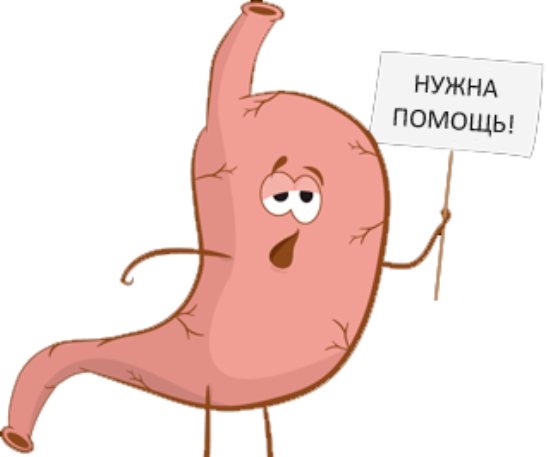
Timely and high-quality diagnosis of gastrointestinal diseases makes it possible to create effective treatment tactics and maintain the patient’s health. Endoscopic methods expand the possibilities of alternative methods for identifying such ailments: X-ray contrast, clinical and laboratory. Gastric biopsy using endoscopy (FGS) is considered the most informative and safe diagnostic technology.
A biopsy is used to assess the condition of the mucous membrane after treatment, to diagnose organ diseases and determine their severity, and to identify pre-tumor and tumor diseases.
A gastric biopsy helps to establish the type of tumor and create effective tactics for further treatment. A biopsy is the removal of a piece of tissue for microscopic examination. Next, the material itself is examined using the method of histology (a tissue sample is evaluated) or cytology (the shape and condition of cells taken as an imprint smear is analyzed).
As a rule, tissue collection is carried out using the following methods:
- targeted (when a pathology has already been detected, and the doctor takes a sample at the border between healthy and diseased tissue);
- search (during the examination, the specialist looks for altered areas: compactions, ulcers, polyps, submucosal formations).
How to prepare for a gastric biopsy procedure?
On the day of the examination you should not eat until the procedure is carried out. You can easily have dinner before 6 pm the night before. You do not need to adhere to a special diet before the biopsy, but 2 days before the biopsy you should exclude chocolate, nuts, seeds and alcohol from your diet. The last drink of water is at least 2, preferably 4 hours before the test.
The cost of a gastric biopsy using endoscopy (without the cost of histological examination) at the Light Diagnostics and Treatment Center is 200 rubles.
You can sign up for the study by calling 711-100.
Indications and contraindications for biopsy during gastroscopy
The procedure is prescribed to identify a tumor and determine its benignity. In most cases, this study is sufficient to make a correct diagnosis. If an incomplete biopsy result is obtained, the doctor prescribes an immunological diagnosis. In this case, the tissue obtained by pinching is treated with various antitumor drugs. This allows you to fully assess their reaction.
The procedure is contraindicated in the following cases:
- for pulmonary and heart failure, atherosclerosis, heart attack and stroke, mental illness, severe obesity, hemophilia, esophagospasm, narrowing of the esophagus, ulcers and varicose veins in this area, large diverticula and kyphosis;
- It is carried out with caution in case of angina pectoris, hypertension, acute diseases of the larynx, esophagus, pharynx and tonsils, pronounced neurasthenia, acute and chronic gastritis, threatening perforation, enlarged lymph nodes in the mediastinum and neck.
In case of gastric bleeding, the procedure is carried out only 2 weeks after it stops. Before diagnosis, an X-ray examination of the stomach is prescribed, which helps identify possible contraindications.
Progress of the procedure
A biopsy is performed during an endoscopy of the esophagus. The patient must be hungry; if the esophageal tube narrows at the entrance to the stomach, rinsing is carried out first.
The manipulation does not require hospitalization and is often done with the patient fully conscious. The endoscope is inserted through the mouth, so endoscopy “in your sleep,” that is, under short-term intravenous general anesthesia, is preferable for both the patient and the doctor.
The endoscopy lasts a maximum of three quarters of an hour, and the biopsy is performed in a fraction of a second.
It is not advisable to eat in the first three hours after the examination; you should not eat spicy or hot foods until the next day.
We will call you back, leave your phone number
Message sent!
expect a call, we will contact you shortly
